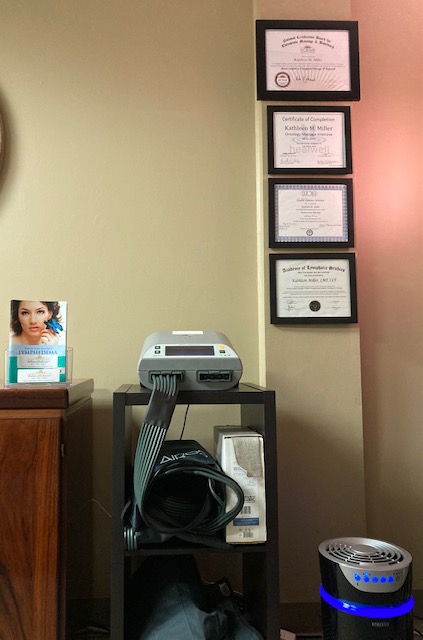
LYMPHEDEMA TREATMENT
If you are recovering from cancer surgery or an elective procedure where lymph nodes have been removed, your doctor may diagnose you with Lymphedema based on your symptoms.
What is Lymphedema?
Our bodies have a network of vessels and nodes that drain and carry lymph fluid throughout the body; very similar to the way blood vessels move blood. This lymph fluid contains proteins, white blood cells, salts, and water. Lymph nodes work to filter out harmful substances such as bacteria, viruses, or cancer cells. The lymphatic system helps us fight infection. Clusters of lymph nodes are located in the armpits and groin areas. Their job is to help return the body’s fluids to the heart.
When nodes have been surgically removed or damaged by radiation, they cannot function properly. Lymphedema occurs when there is a build-up of lymph fluid in the tissues. This causes swelling or a feeling of fullness, mostly in the arms or legs. This swelling can become chronic and trigger changes in your skin and tissues that put you at risk for additional swelling, infections, and decreased mobility. Swelling from Lymphedema is often uncomfortable and sometimes severe enough to cause disfigurement.
Massage for Lymphedema Management (MLD)
Manual Lymph Drainage (MLD) is a gentle, skin-deep massage technique that moves lymphatic fluid in areas where the flow is inadequate due to lymph node damage. MLD is not intended to release knots in muscle, but rather to detoxify tissues and reduce swelling from Lymphedema. It is also very calming; with soft, rhythmic movements that often lull the client into an extremely relaxed state.
Because Lymphedema is a common side effect of cancer treatment, it may often occur in the arm on the same side as a mastectomy or lumpectomy. According to the American Cancer Society and Oncology Nurse Advisor Website, “Approximately 20% of women who have had axillary lymph node dissection (ALND) will be affected” and even a sentinel node biopsy creates a 5% risk of developing Lymphedema. For this reason, deep massage should NEVER be done on the affected limb.
Cancer patients and survivors at risk of developing Lymphedema can benefit from regular Manual Lymph Drainage sessions and can help keep Lymphedema under control.
Treatment for Lymphedema
Lymphedema treatment focuses on reducing the swelling and controlling the pain. This includes bandaging your entire arm or leg to encourages lymph fluid to flow back toward the trunk of your body. Compression garments required a proper fit to provide the most success and comfort in reducing fluid build up.
Complete Decongestive Therapy (CDT) is an approach that involves combining therapies with lifestyle adjustments. Contraindications are high blood pressure, diabetes, paralysis, heart failure, blood clots or acute infections.
LYMPHEDEMA TREATMENT
Manual Lymph Drainage MLD, Complete Decongestive Therapy is effective in moving lymph out of the swollen limb to the healthy side to be processed through the lymphatic system. This light and gentle treatment technique reduces swelling, increases mobility, requires less bandaging and use of garments for maintenance of Lymphedema.
VIBRATIONAL LYMPHATIC MASSAGE
Did you know that sound therapy can alleviate chronic pain from old injuries, migraines, and debilitating disease? With the use of specific Tuning Forks and essential oils for the lymphatic system, change occurs when sound waves pass through the skin, organs, tissue, right down to the cellular level of our bodies. As a result, the release of scar tissue, fascia, and muscle pain can be released, decreasing pain and increasing movement. Highly recommended for post-surgery recovery of breast cancer, radiation treatment, and reconstruction.

